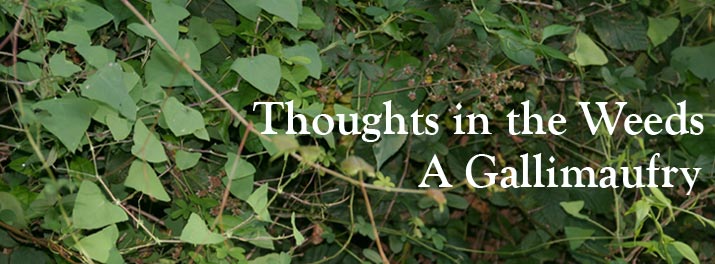It may be that if you weed too much, you get a bit goofy. Different weeds take on different personalities and you treat them accordingly. What follows is a conversation with one of my least favorites: Five-leafed Akebia.
Weeder: Good morning, Akebia shoot, I see you’re back.
FLA: Yup.
Weeder: I pulled you out just two weeks ago — maybe a week and a half.
FLA: (sullen) Yeah, that hurt. But I got over it.
Weeder: So why do you keep growing? Why do you keep strangling other plants? Why won’t you cooperate?
FLA: (flatly) It’s what I do. It’s my destiny
Weeder: But you’re so relentless.
FLA: It’s my purpose, to grow and reproduce. (livening) It’s your purpose, too, by the way: grow and reproduce.
Weeder: Well, yes, but I do other things as well.
FLA: (increasingly more engaged) Yeah, other stupid things. Like worrying about why you’re here. Stupid waste of time. You’re here because you’re here, that’s all. And worrying about purpose. Just grow and reproduce, like me. And multi-tasking. If you just stuck to one thing, you’d be a lot more productive, like me.
Weeder: Well, I was more restrained about the reproduction business: two children, max.
FLA: That’s fine for you, you’re taking over the earth anyway, with all your stupid buildings and your stupid chemicals and your stupid fancy plants. God, I hate those rhododendrons and how you baby them! Let them stand up for themselves and fight like real men, I say. We weeds have to keep growing just to keep up.
Weeder: OK, OK, granted, we aren’t very good stewards of the earth…
FLA: I’ll say. And we got here first.
Weeder: But why do you have to do your growing on my property? Can’t you fulfill your destiny somewhere else?
FLA: I like you.
Weeder: LIKE ME! How can you like me? I do my best to eradicate you. Not that I’m very successful at it.
FLA: Actually, I even love you. Because you don’t use chemicals. Remember when your neighbors drowned the place with Roundup?
Weeder: Yeah, the whole neighborhood reeked for a week, made me choke.
FLA: (angry and morose) And then they came back and did it again. Wiped out my whole family, they did. Uncle Charlie, Aunt Mildred, all my brothers and sisters, all the little nieces and nephews. It was devastating. Planticide! An herbal holocaust!
Weeder: Well, although I hated it at the time, it worked.
FLA: (outraged) It certainly did, all too well. We’ve had to redouble our efforts on your side of the fence.
Weeder: Well, thank you very much.
FLA: And another thing. If you’d just stop worrying about those fancy plants and put up an arbor for me to grow on, we’d get along a lot better. I could be beautiful. I could hide that awful mess that your stupid mechanic son makes in the back yard — all those tires and trucks. It looks like Appalachia back there…
Weeder: Yes I know. I try…
FLA: (primping) I would be beautiful. I have round rich green leaves in neat clusters of five. I have pretty little flowers…
Weeder: I’ve never seen your flowers.
FLA: (outraged again) See that! You haven’t been looking. All you do is yank and snip, yank and snip. You don’t even pay attention to what you’re doing! Stop and smell the roses — oops, I mean honeysuckle — Weeder. My flowers are subtle.
Weeder: I’ll think about it — that arbor thing. But only if you promise not to go anywhere else in the garden.
FLA: No promises.
Weeder: Well, then…
FLA: OW!!





 And the targets have moved throughout history. Cathcart points out that when printing with movable type was invented in the 15th century, there were predictions of doom, of the death of knowledge. In fact, to the contrary, the printing press increased the reach of knowledge and facilitated an expansion of knowledge greater than any invention since the development of standardized writing.
And the targets have moved throughout history. Cathcart points out that when printing with movable type was invented in the 15th century, there were predictions of doom, of the death of knowledge. In fact, to the contrary, the printing press increased the reach of knowledge and facilitated an expansion of knowledge greater than any invention since the development of standardized writing.











